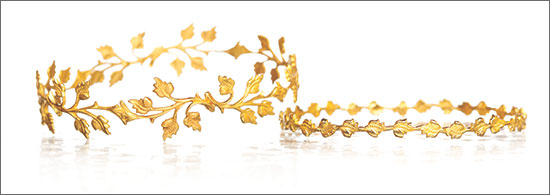Forging Better Working Relationships with Subcontractors
When searching for subcontractors, you can learn a lot from your friends in the jewelry industry. Many designers and jewelers rely on peer referrals to find the right person for the job. And once they've entered into an agreement with a contract service provider, they learn tips for keeping that relationship on track from the stories their friends tell about their subcontracting successes and failures. In this article, you'll read about the experiences of jewelers just like you who have met their business goals with the help of subcontractors. The lessons they've learned will show you what to expect when working with subcontractors, and ultimately help you to forge better working relationships with them.
4 Minute Read
In this article, you'll read about the experiences of jewelers just like you who have met their business goals with the help of subcontractors. The lessons they've learned will show you what to expect when working with subcontractors, and ultimately help you to forge better working relationships with them.
When searching for subcontractors, you can learn a lot from your friends in the jewelry industry. Many designers and jewelers rely on peer referrals to find the right person for the job. And once they've entered into an agreement with a contract service provider, they learn tips for keeping that relationship on track from the stories their friends tell about their subcontracting successes and failures.
Robin Haley
Robin Haley Jewelry, Nashville, Tennessee
An industry veteran of 30 years, bench jeweler Robin Haley began using subcontractors to increase production. She wanted to get back into gold on a larger scale than custom work, so she designed a high-end line and outsourced the casting and finishing processes. She sets some stones but outsources the setting for any pieces that will be too time-consuming to do in-house.
"If I want a diamond or a couple of diamonds in a piece, I'll do it myself," she says. "If there are a lot, I send it out. Otherwise, I know I won't get my work done."
It all comes down to time. "In the last three years, I've completely tapped out the resource of doing it all myself," she says. "I think you take a look at your workload as your business grows, and you start looking for someone who would do the quality of work you would accept."
To find subcontractors who meet her standards, she contacted friends in the business for references and consciously chose service providers located in New York City. Because her caster, finisher, and diamond setter are all in one building, they can walk her work from one step to the next. "Since I live out of town and I can't go do this myself, I am fortunate that I have good enough relationships with them that they do this for me," says Haley. "This also avoids some shipping costs, which can really add up. I compete with jewelers who have their work done in India or China, so the extra shipping costs are all it could take to make my jewelry too costly."
Perhaps one of the biggest benefits of having all of her subcontractors in the same building is that it adds another level of quality control to her work. "There are a few leaf designs that I have that periodically come out of the mold with missing leaves," she explains. "My finishers will catch these errors for me — they have a diagram of what each leaf is supposed to look like — and will return a piece that is faulty and ask the caster to re-cast it, avoiding the time and expense of it coming all the way over to me with errors and requiring a total do-over."
Despite the good working relationships she has forged, Haley says she will never use subcontractors for all aspects of her work. "I think that when jewelry is handmade by the artist, it carries an energy," she says. "I'm more proud of that product."
Jane Bohan
Jane Bohan Inc., New York City
Jane Bohan had a full shop with office staff and bench jewelers for 15 years. But about 10 years ago she changed her business model, closed her shop, and became a one-woman office — subcontracting everything beyond her initial sketch.
"I was already familiar with working with subcontractors, as we had always sent out stone setting and hired outside help during extra busy periods," says Bohan. Moving exclusively to subcontracting freed Bohan of the overhead required to run a manufacturing shop, yet still enabled her to take advantage of the talent required to bring her visions to life.
"Because I live in New York City, I am fortunate to have a wealth of very talented jewelers who can manufacture to my standards who have their own shops," she says. "I reduced my overhead by moving to a smaller office and not having such a large staff year round. For example, the busiest time of the year has always been the fall, yet I had to carry the payroll and all associated costs of having well-trained jewelers employed year-round under my roof."
The move also simplified business finances. "It's easier to judge my costs because I know exactly what my labor cost is by paying by the piece," says Bohan. "Sometimes the piece can be more money to manufacture than I had anticipated, and then I re-think the process."
Today she has an office with a design table, bench, desk, and a private space for meeting with clients — all three blocks from home. She works exclusively with contract service providers who specialize in model making, casting, and stone setting.
But her newer way of working did come with some drawbacks. "The pitfall is not having jewelers whose only responsibility is directly tied to my manufacturing requirements," she says. "It was a little bit of a hard transition that I couldn't just turn to someone and say 'let's try it right now.' If there is a rush job or I have an idea I want to try out immediately on the bench, it can be much harder to execute this when I am one of several of the jewelry contractor's clients."
That said, for Bohan the benefits outweigh the drawbacks. "This system allows me more flexibility personally and provides a better way for me to manage my manufacturing costs," she says. "As a small company, I feel the benefits of using outside contractors are vast."
The award-winning Journal is published monthly by MJSA, the trade association for professional jewelry makers, designers, and related suppliers. It offers design ideas, fabrication and production techniques, bench tips, business and marketing insights, and trend and technology updates—the information crucial for business success. “More than other publications, MJSA Journal is oriented toward people like me: those trying to earn a living by designing and making jewelry,” says Jim Binnion of James Binnion Metal Arts.
Click here to read our latest articles
Click here to get a FREE four-month trial subscription.
You assume all responsibility and risk for the use of the safety resources available on or through this web page. The International Gem Society LLC does not assume any liability for the materials, information and opinions provided on, or available through, this web page. No advice or information provided by this website shall create any warranty. Reliance on such advice, information or the content of this web page is solely at your own risk, including without limitation any safety guidelines, resources or precautions, or any other information related to safety that may be available on or through this web page. The International Gem Society LLC disclaims any liability for injury, death or damages resulting from the use thereof.
The All-In-One Jewelry Making Solution At Your Fingertips
When you join the Ganoksin community, you get the tools you need to take your work to the next level.
Trusted Jewelry Making Information & Techniques
Sign up to receive the latest articles, techniques, and inspirations with our free newsletter.



